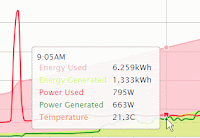 |
| Electricity Audit Service |
This service primarily targets Aussie householders with major concerns over rising electricity costs. Where electricity use can be totally out of control!
When is your electricity bill going to push a button?
The electricity audit is designed to create awareness and importantly educate you on all aspects of,
- Understanding your electricity bill
- Home electricity use
- Energy efficient appliances
- Electricity monitoring
- Electricity retailer's options
- Electricity standby costs
- Electricity tariffs
- Energy efficiency versus energy use
Our Home Electricity Usage Audit will offer you clarity on issues such as,
- The true cost of standby in your home, due to appliances being left on
- The true cost of a 250L HW system and what you are not being told
- How much it costs you to run a pool pump
- Where you are using the most electricity in your home
- What the most effective / efficient form of electric heating is
Now there is really no reason to guess anymore! Guess work that has so far cost you dearly on each and every electricity bill! And of course will continue to do so, unless you take action today!
Our Home Electricity Audit comes complete with a detailed report.
This blog post and podcast brought to you by Aussie Home Energy, a major player in the HOME ELECTRICITY REDUCTION SERVICE industry in Australia.







